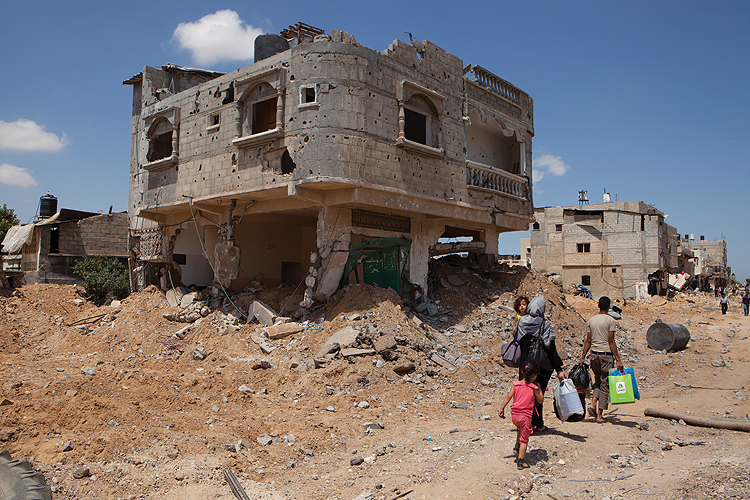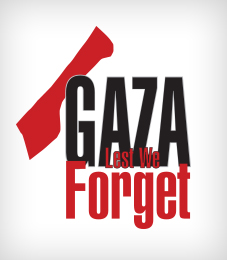
Families, as they prepare their daily meals, are buying supplies as a donation for the people of Gaza. One package of rice for me, and one for you.i Other individuals are volunteering their time to arrange and package supplies. Supermarkets are not only facilitating these donations of supplies but some are also participating in the boycott of Israeli products.ii They say “Let’s stop funding the destruction of our brothers and sisters in Gaza.”
Banks have donated $250,000 to relief efforts.iii
Everyone seems to be doing something within his or her means to support Gaza. This time, however, it seems that the group most capable of supporting Gaza is the private sector. Not only has the human suffering and the number of lives lost exceeded that of the previous military campaigns, but also the damage to infrastructure and private business. The Palestinian Central Bureau of Statistics estimated that economic losses in Gaza from the 2008–2009 aggression totalled $804 million.iv The Alternative Aid Center estimates that, as of August 3, the latest aggression has caused economic losses standing at $1,590 million.v
Al Awda Co. in Deir Al Balah, which has been an important pastry factory for over 40 years, has been completely destroyed. The owner, Mohammad Al Telbani, had announced just days earlier that they would supply their trademarked Choco Sandwich biscuits to refugees in UN schools.vi
Assessing some of the damage during the temporary ceasefire on August 3, reporters noted that 175 of Gaza’s most successful industrial plants had been severely damaged. Prior to this latest Israeli military operation, the unemployment rate in the Gaza Strip was 47 percent and was only expected to rise with hundreds of production companies now unable to operate.vii
The damage incurred during the attack has plunged the Gaza Strip into an even deeper dismal economic hole. Here is the role of the Palestinian private sector: To not only rebuild Gaza but also to enable a level of sustained economic activity and investment. How is this done?
A 2012 PalThink report attributed the economic conditions in the Gaza Strip to the Israeli blockade, effectively implemented since 2005, and frequent military incursions. For example, in 2007, 400 truckloads ($8 million) of furniture made in the Gaza Strip were stranded, unable to be exported to Israeli and international markets. PalThink reports that the furniture industry that year was operating at less than 5 percent of its capacity due to these restrictions.viii
The question becomes: How can the Palestinian private sector use its leverage to increase the opening of these borders and invest in the human resources of Gaza? How does the private sector ensure that the materials and expertise needed to rebuild the private sector of Gaza successfully enter the Strip? Supplies for urgent humanitarian assistance are necessary and crucial, but we must find ways to support the construction sector in rebuilding the thousands of homes destroyed during the attack. How does the Palestinian private sector ensure that concrete reaches those who are trying to rebuild homes?ix
Responsibility falls first upon those companies with branches or factories in Gaza to support their counterparts. But responsibility falls more broadly on a unified effort on the part of the Palestinian private sector to use its influence and leverage to remove the border restrictions and invest in Gaza’s human resources. In this way, we enable and support Palestinians in Gaza to build a resilient, vibrant economy that is integrated with the West Bank’s private sector and that draws upon the strength of its people.
» Dalia Association is the first Palestinian community foundation established as a way to realise the right of Palestinians to control resources and sustain development for generations to come. Dalia’s Gaza Fund Campaign is a way for private-sector companies to invest in grassroots civil society in Gaza. For more information, visit www.dalia.ps.
- i Daoud Kuttab, “West Bank Palestinians Raise Money for Gaza,” Al-Monitor, August 1, 2014.
- ii Shawn Carrie, “As Relief Supplies Make Their Way to Gaza, Boycott of Israeli Products Spreads in West Bank,” Palestine News Network, August 7, 2014.
- iii Information provided by an UNRWA representative at a meeting of the Palestinian private sector, August 7, 2014. Reports from the meeting can be found at: http://www.al-ayyam.com/article.aspx?did=244877&date; http://www.wafa.pna.net/arabic/index.php?action=detail&id=181329; http://www.pal24.net/ViewNews.aspx?ID=37908.
- iv http://www.pcbs.gov.ps/Portals/_pcbs/PressRelease/Gaza_lost_e.pdf.
- v “Statistics on the Israeli Offensive against Gaza,” Alternative Information Center, August 3, 2014.
- vi Rami Almeghari, “Israel ‘wipes out’ Gaza Ice Cream Factory that Stored Vital Medicines,” Electronic Intifada, August 2, 2014; Jodi Rudoren and Fares Akram, “Conflict Leaves Industry in Ashes and Gaza Reeling from Economic Toll,” The New York Times, August 6, 2014.
- vii Nigel Wilson, “Gaza Strip Rebuilding to Cost Billions of Dollars,” International Business Times, August 12, 2014.
- viii Reham Al Wehaidy, Private Sector: Impact of the Gaza Blockade and Strategies to Cope with its Consequences, PalThink for Strategic Studies, October 22, 2012.
- ix Nicholas Casey, Jay Solomon, and Joshua Mitnick, “Cease-fire Brokers Grapple with How to Rebuild Gaza,” Wall Street Journal, July 24, 2014.


